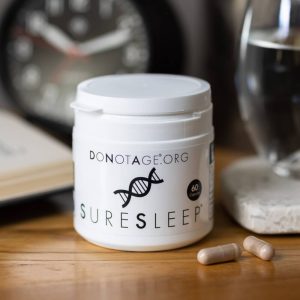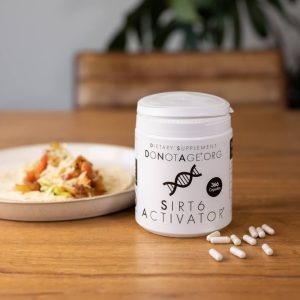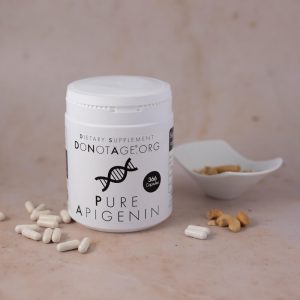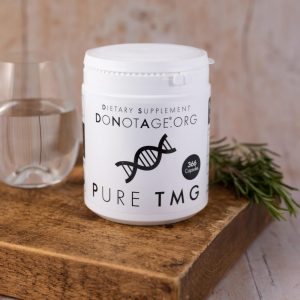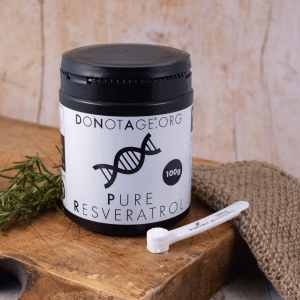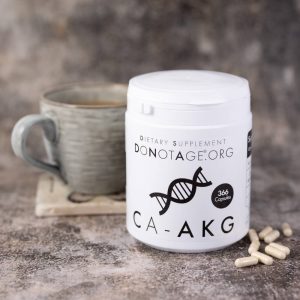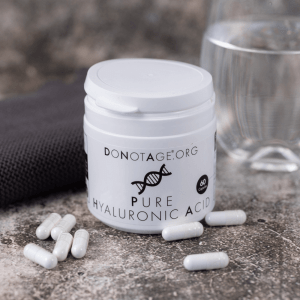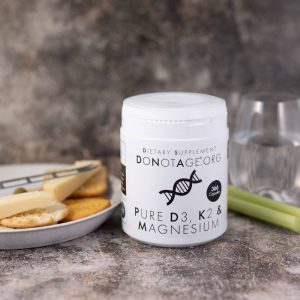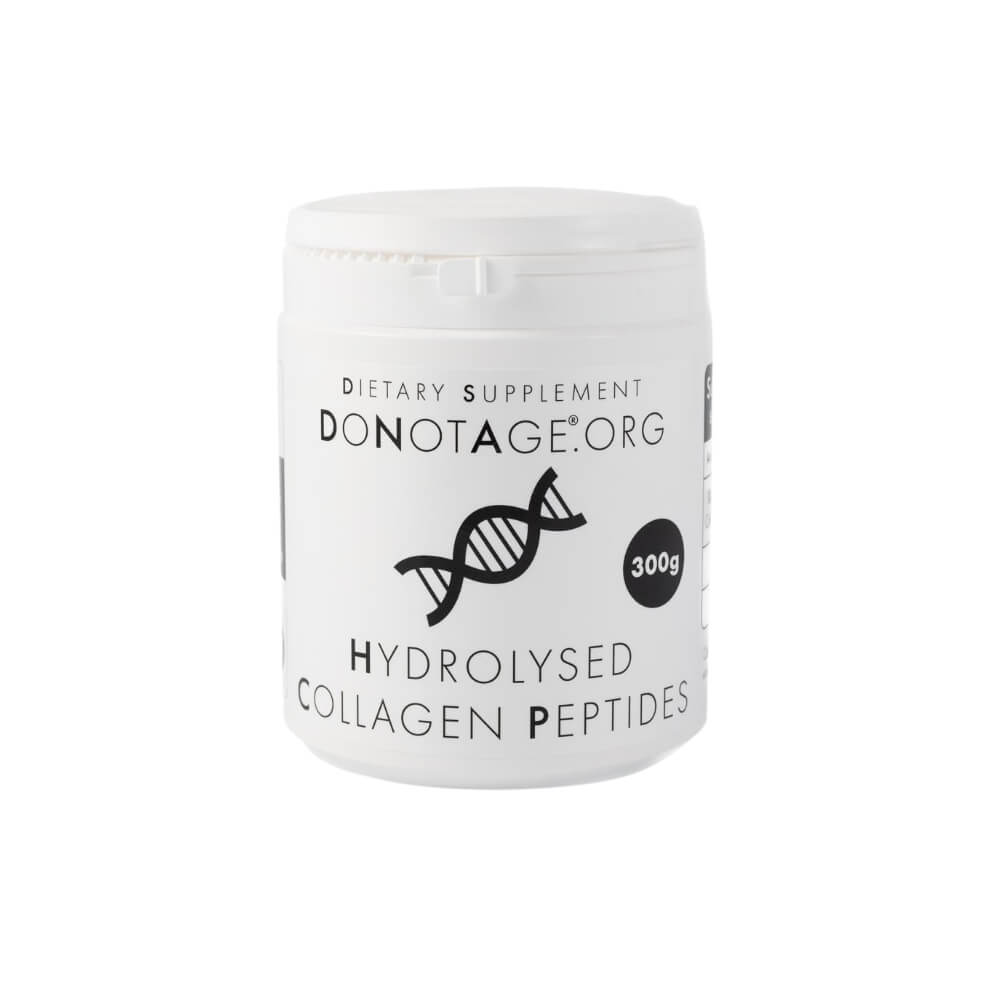THE SCIENCE
Caloric restriction is often referred to as the most proven way to extend life, with some studies showing an 83% increase in lifespan. Cutting your calorie intake by 15% whilst also using supplements can protect against cancer, diabetes and dementia.
Fasting is something that is done by many cultures around the world. Some do it as part of a religious holiday or ritual, while others choose to do it for the fantastic health benefits. While it is something that can work incredibly well when it comes to losing weight and improving your health and longevity, it also depends on the food that you eat. A person who chooses to eat a small McDonald’s meal every day would have a lesser result than someone who eats healthily.
Intermittent fasting is thought to reduce age-related diseases, such as cancer. It has also been shown to improve heart health, cholesterol, blood pressure, brain health, oxidative stress, immunity and insulin sensitivity, without leaving you hungry. Additionally, fasting has been proven to be a good way to lose weight, whilst keeping your muscle mass.
Blood pressure, resting heart rates, and other heart-related issues can all be improved by intermittent fasting. physical activity. 16-hour fasting young men demonstrated fat reduction while retaining muscle mass. Studies have shown that mice that were fed on different days displayed greater running endurance than those fed every day.
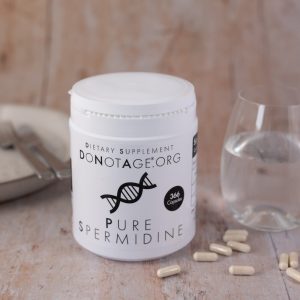
Useful links:
- Effects of intermittent feeding upon growth and life span in rats
- Support the Rate of Living and Oxidative Damage Theories of Aging: Cell Metabolism
- Energy restriction and the prevention of breast cancer
- Early Time-Restricted Feeding Improves Insulin Sensitivity, Blood Pressure
- Intermittent fasting during Ramadan
- The effects of three-week fasting diet
- Intermittent fasting and caloric restriction
- Intermittent versus daily calorie restriction
Regular exercise reduces the chance of early death. Exercise helps with quality of life too, preventing chronic diseases, depression and frailty.
We’ve always had exercise as a miracle treatment, but we’ve been neglecting it for far too long. As a result, health is currently deteriorating.
Whatever your age, there is compelling scientific evidence that leading an active lifestyle can improve your overall health and happiness.
Regular exercisers are less likely to suffer from chronic diseases, including:
- Heart disease
- Type 2 diabetes
- Stroke
- Some types of malignancies
According to research, physical activity also lowers your chances of stress, clinical depression, dementia, and Alzheimer’s disease while boosting self-esteem, mood, sleep quality, and energy.
Exercise can boost your NAD levels, increase the size of your brain and in turn, boost your memory. It seems that interval training has superior health benefits to other types of exercise.
Useful links:
- Health benefits of physical activity
- Is Exercise a Viable Treatment for Depression?
- Physical Exercise as Therapy for Frailty
- Exercise training increases size of hippocampus and improves memory
- Aerobic and resistance exercise training reverses age‐dependent decline
- Enhanced Protein Translation Underlies Improved Metabolic and Physical Adaptations
Sulforaphane is a compound found in cruciferous vegetables (when they are raw) such as broccoli and cabbage. The compound is not stable, so to create a supplement, sulforaphane glucosinolate and an enzyme called myrosinase must be mixed together. SulforaBoost® is the most effective sulforaphane product available.
Sulforaphane has been shown to relieve oxidative stress, reduce cancers, protect against UV damage and sunburn, protect the liver and reduce viral load. This can help with both the body’s internal and external health.
Dr Rhonda Patrick says:
“There’s tons and tons of studies showing that taking these products increases levels of glutathione in blood and also in the human brain. If you don’t know what glutathione is, it’s the major, major antioxidant, particularly in the brain. It’s not only increasing the antioxidant systems it’s decreasing DNA damage, quite significantly by 30%, and this is in humans. Very important.”
Sulforaphane has been shown to protect the heart, conserve the brain and protect from pollution.
The two main avenues that sulforaphane’s benefits come from are the activation of the Nrf2 pathway and increasing glutathione levels. For this reason, sulforaphane is often referred to as the “cell defender”.
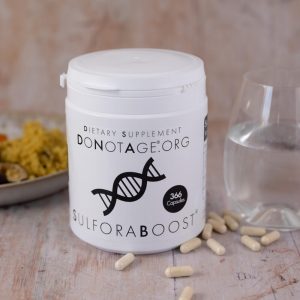
Useful links:
- Phase 1 study of multiple biomarkers for metabolism and oxidative stress after one-week intake of broccoli sprouts
- Broccoli sprouts powder could improve serum triglyceride and oxidized LDL/LDL-cholesterol ratio in type 2 diabetic patients
- Dietary Sulforaphane in Cancer Chemoprevention
- Sulforaphane, a dietary component of broccoli/broccoli sprouts, inhibits breast cancer stem cells
- Sulforaphane induces caspase-mediated apoptosis in cultured PC-3 human prostate cancer cells and retards growth of PC-3 xenografts in vivo
- Sulforaphane (SFN): An Isothiocyanate in a Cancer Chemoprevention Paradigm
- Sulforaphane mobilizes cellular defenses that protect skin against damage by UV radiation
- Broccoli sprout extract induces detoxification-related gene expression and attenuates acute liver injury
- Natural Killer Cells: A Randomized, Double-Blind Study
- Sulforaphane-rich broccoli sprout extract attenuates nasal allergic response to diesel exhaust particles
- Modulation of the metabolism of airborne pollutants by glucoraphanin-rich and sulforaphane-rich broccoli sprout beverages in Qidong, China
- Effect of Broccoli Sprouts and Live Attenuated Influenza Virus on Peripheral Blood Natural Killer Cells
- Antioxidant enzyme induction
- The influence of sulforaphane on vascular health and its relevance to nutritional approaches to prevent cardiovascular disease
- Sulforaphane activates the cerebral vascular Nrf2-ARE pathway and suppresses inflammation to attenuate cerebral vasospasm in rat with subarachnoid hemorrhage
- Effects of sulforaphane and vitamin E on cognitive disorder and oxidative damage in lead-exposed mice hippocampus at lactation
- Sulforaphane improves outcomes and slows cerebral ischemic/reperfusion injury via inhibition of NLRP3 inflammasome activation in rats
- Sulforaphane reactivates cellular antioxidant defense by inducing Nrf2/ARE/Prdx6 activity during aging and oxidative stress
- Sulforaphane Augments Glutathione and Influences Brain Metabolites in Human Subjects
- Sulforaphane and Other Nutrigenomic Nrf2 Activators
Autophagy literally means “self-eating”. This natural bodily process helps us to get rid of old and damaged cells and create new healthy ones. A lack of autophagy is heavily linked to cancer, as the body does not remove those cancerous cells as it should. Autophagy can be activated by performing extended fasts (over 48 hours) or supplementing with ingredients such as spermidine.
The anti-ageing properties of autophagy appear to be its primary advantage. In fact, it’s best recognised as the body’s method of producing younger cells.
When our cells are under stress, autophagy levels increase to assist and protect us, lengthening our lifespan.
Additionally, autophagy can maintain the body’s functioning during times of deprivation by disassembling cells and repurposing them for essential functions.
Naturally, this requires energy and cannot go on indefinitely, but it provides us more time to acquire food.
The advantages of autophagy at the cellular level include:
- Eliminating the harmful proteins from cells that are linked to neurodegenerative illnesses including Parkinson’s and Alzheimer’s
- Recycling leftover proteins promotes regeneration and healthy cells by giving energy and building blocks to cells that could still use extensive repair.
- The potential role autophagy may play in preventing or treating cancer is also attracting a lot of attention.
According to Keatley, “autophagy declines with age, which implies that cells that no longer function or may cause harm are permitted to grow, which is the MO of cancer cells.”
While all malignancies originate from damaged cells of some kind, the body should be able to identify and eliminate those cells, frequently through autophagic processes. Some scholars are considering the idea that autophagy may decrease the risk of cancer.
Spermidine has been shown to delay ageing in humans. It is known as a geroprotector, with most benefits coming via autophagy. Spermidine is shown to:
- Extend lifespan.
- Improve resistance to stress.
- Decrease the occurrence of age-related diseases.
- Prevent the loss of movement.
- Protect the heart.
- Protect the cardiovascular system.
- Protect the immune system.
Spermidine has also been shown to upregulate sirtuin 1, prevent liver damage and cancer, act as an anti-inflammatory and even promote human hair growth. It may also protect telomere length.
Spermidine may slow down human ageing, prevent age-related disorders, increase sirtuin 1, defend against liver damage, have anti-inflammatory effects, and improve cognition, all while warding off diseases of the brain including dementia and Parkinson’s, according to studies.
One of spermidine’s most prominent benefits is its effect on the brain. Spermidine can protect your memory, boost your cognitive abilities and stop neurodegeneration.
Levels of spermidine decrease as we age, and a higher spermidine intake reduces the chance of dying.
Useful links:
- Spermidine delays aging in humans
- Molecular basis of the ‘anti-aging’ effect of spermidine and other natural polyamines
- The Quest to Slow Ageing through Drug Discovery
- Cardioprotection and lifespan extension by the natural polyamine spermidine
- Spermidine Promotes Cardioprotective Autophagy
- Spermidine alleviates cardiac aging by improving mitochondrial biogenesis and function
- Induction of autophagy by spermidine promotes longevity
- Autophagy mediates pharmacological lifespan extension by spermidine and resveratrol
- The Autophagy Enhancer Spermidine Reverses Arterial Aging
- Spermidine inhibits vascular calcification in chronic kidney disease through modulation of SIRT1 signaling pathway
- Spermidine Prolongs Lifespan and Prevents Liver Fibrosis and Hepatocellular Carcinoma
- Autophagy in malignant transformation and cancer progression
- Caloric Restriction Mimetics Enhance Anticancer Immunosurveillance
- Molecular Basis of the ‘Anti-Aging’ Effect of Spermidine and Other Natural Polyamines
- Spermidine Promotes Human Hair Growth and Is a Novel Modulator of Human Epithelial Stem Cell Functions
- A spermidine-based nutritional supplement prolongs the anagen phase of hair follicles in humans: a randomized, placebo-controlled, double-blind study
- Novel aspects of age-protection by spermidine supplementation are associated with preserved telomere length
- Restoring polyamines protects from age-induced memory impairment in an autophagy-dependent manner
- Spermidine protects against α-synuclein neurotoxicity
- Spermidine inhibits neurodegeneration and delays aging via the PINK1-PDR1-dependent mitophagy pathway in C. elegans
- Safety and tolerability of spermidine supplementation in mice and older adults with subjective cognitive decline
- The positive effect of spermidine in older adults suffering from dementia
- Induction of autophagy by spermidine is neuroprotective via inhibition of caspase 3-mediated Beclin 1 cleavage
- (PDF) Induction of autophagy by spermidine promotes longevity
- Higher spermidine intake is linked to lower mortality: a prospective population-based study
Sleep is a vital part of staying healthy, but the majority of adults struggle with it. Your body shuts off from the outside world and begins its daily clean-up. Your brain uses sleep to check its hormones and enzymes are in balance. The cells contract and waste are washed away. If this does not happen, then the brain ages much faster and can lead to diseases such as dementia.
Sleep is important for mental well-being as well as physical. Those lacking in sleep are more likely to:
- Be overweight.
- Have disrupted appetites.
- Lose empathy.
- Have more inflammation.
- Have a low immune system.
- Be depressed.
- Be suicidal
- Have impaired brain function.
- Are more at risk for heart problems.
- Those sleeping for less than 7 hours per night have up to a 26% higher risk of death.
Ultimately, sleep is paramount to having a long and healthy life. Some tips to have quality sleep include:
- Drinking enough water.
- Having enough melatonin.
- Reducing blue light in the evening.
- Stick to a sleep schedule.
- Avoid caffeine and alcohol
- Sleep in a restful environment.
- Increase physical activity in the day.
Everybody experiences nights when it’s difficult to go to sleep or when we wake up during the night. Sleep issues are common, but if our suggestions don’t help or if you’ve been having trouble sleeping for months and it’s making it difficult for you to cope, you might benefit from further treatment from a medical professional.
Useful links:
- Sleep and Sleep Disorders in Older Adults
- Coupled electrophysiological, hemodynamic, and cerebrospinal fluid oscillations in human sleep
- Meta-Analysis of Short Sleep Duration and Obesity in Children and Adults
- Short Sleep Duration Is Associated with Reduced Leptin, Elevated Ghrelin, and Increased Body Mass Index
- The effects of sleep deprivation on emotional empathy
- Sleep and Inflammatory Bowel Disease
- Partial night sleep deprivation reduces natural killer and cellular immune responses in humans
- Association of poor subjective sleep quality with risk for death by suicide during a 10-year period
- Moderate sleep deprivation produces impairments in cognitive and motor performance equivalent to legally prescribed levels of alcohol intoxication
- Sleep duration predicts cardiovascular outcomes
- Sleep and mortality
- Water, Hydration and Health
- Effect of Light on Human Circadian Physiology
- What’s in a Color? The Unique Human Health Effects of Blue Light
SureSleep® contains 3 active ingredients to help get you to sleep, stay asleep, and benefit from the lack of fatigue afterwards.
When it senses that it is time to go to bed, your body releases melatonin, which is primarily dependent on exposure to light. Our melatonin production is impacted by the fact that we are all exposed to artificial light late into the evening, which in turn impacts the quality of our sleep. The generation of melatonin is also impacted by ageing, so as you become older, your sleep quality declines even more.
Rhodiola Rosea is an adaptogen that is a natural substance that stimulates the body’s resistance to stressors. It is commonly used to fight fatigue, anxiety, depression and stress. An extract from the plant has also been shown to kill cancer cells in humans.
Valerian root has long been used to induce sleep, and for good reason. It has been shown to improve sleep significantly, as well as reduce anxiety.
Prunus cerasus, sometimes called tart or sour cherry, is traditionally known as a powerful antioxidant. However, on top of this, prunus cerasus has now been shown to significantly elevate natural levels of melatonin, the sleep hormone. It significantly increases time in bed, total sleep time and sleep efficiency.
Long-term direct melatonin supplementation can stop your body from producing its own melatonin, which is not what we want. Do Not Age has worked very hard to develop the ideal product that will help you get a restful night’s sleep and wake up feeling rejuvenated.
Useful links:
- The Effects of Rhodiola rosea L. Extract on Anxiety, Stress, Cognition and Other Mood Symptoms
- Stress management and the role of Rhodiola rosea
- Rhodiola rosea versus sertraline for major depressive disorder
- Salidroside Induces Apoptosis in Human Gastric Cancer Cells via the Downregulation of ENO1/PKM2/GLUT1 Expression
- Valerian Root in Treating Sleep Problems and Associated Disorders—A Systematic Review and Meta-Analysis
- Effect of valepotriates (valerian extract) in generalized anxiety disorder
- Effect of tart cherry juice (Prunus cerasus) on melatonin levels and enhanced sleep quality
NAD or nicotinamide adenine dinucleotide is so vital that without it, you would die within seconds. Your mitochondria, which are responsible for energy production, use NAD as fuel. NAD is also the fuel for your Sirtuins, (you can find out more about Sirtuins below). NAD is crucial for telomeres. They are the caps on your DNA strands that protect your chromosomes, and shortened telomeres are linked to a shorter lifespan.
NAD is a wonderful discovery and extremely important for ageing. Finding ways to boost your NAD levels has become central to longevity.
Some of the benefits of NAD include:
- Higher amounts of physical energy.
- An improvement in mental performance.
- Reduced sleep deprivation significantly.
- Increased anti-ageing initiatives.
- Reduced effects of jet lag.
- Short-term memory is enhanced.
- Improved mental capacity.
There are two main issues with NAD. The first is that as we age, our natural levels of NAD decline, and it is believed that this is the reason for many age-related diseases.
The other problem with NAD is that it is too large to enter your body. This is why we provide NMN, or nicotinamide mononucleotide, to raise your NAD levels. NMN is a direct precursor to NAD and is proven to raise NAD levels.
Useful links:
- NAD+ metabolism and the control of energy homeostasis
- Article NAD + Replenishment Improves Lifespan and Healthspan in Ataxia Telangiectasia Models via Mitophagy and DNA Repair
- Age-Associated Changes In Oxidative Stress and NAD+ Metabolism In Human Tissue
- The Plasma NAD+ Metabolome Is Dysregulated in “Normal” Aging
- Role of Nicotinamide Adenine Dinucleotide and Related Precursors as Therapeutic Targets for Age-Related Degenerative Diseases: Rationale, Biochemistry, Pharmacokinetics, and Outcomes
- Nicotinamide mononucleotide increases muscle insulin sensitivity in prediabetic women
- Healthy aging and muscle function are positively associated with NAD + abundance in humans
Just as NAD decreases with age, CD38 increases as we age. To compound these issues, CD38 is a NADase, which means it reduces our NAD levels. This means that boosting NAD levels is less effective when CD38 is too high. CD38 is inhibited by both Quercetin and Apigenin.
There are three main applications that use NAD. One relates to sirtuins. Many other genes involved in longevity and health can be activated and deactivated by these genes. Another is an enzyme family known as PARPs that is involved in cellular DNA repair. The third is CD38, a second messenger employed by cells to signal the calcium ion. The most important thing to keep in mind is that there is a limited supply of NAD (if one consuming use is excessively active, it may starve the others).
NAD levels decrease as people age. NAD levels may be roughly half of youthful levels by the time we are in our middle years. As they age, they may plummet much farther. Why do NAD levels decline as we age? While there are several causes, CD38 is a key offender.
As you’ll see in this article, CD38 activity and expression rise with age; by advanced age, it may be several-fold greater in various tissues and cells. Sirtuins, PARPs, and CD38 compete with one another for a limited supply of NAD, so when CD38 uses up too much of it, there is less NAD left over for Sirtuins and PARPs to use. The critical work they conduct suffers as a result. This can be changed by slowing CD38, which increases NAD indirectly and makes more of it available for utilisation by sirtuins and PARPs.
Useful links:
Sirtuins are a family of proteins that keep your cells healthy and promote DNA repair. Sirtuin activity decreases as you age, so by increasing that sirtuin activity we can increase your lifespan.
Our cells are protected by sirtuins in the following ways:
- React to damage and repair.
- Encourage strong DNA.
- Associated with the advantages of exercise and fasting.
- Collaborate with other genes and react to cellular harm.
- Create enzymes that regulate the epigenome.
- May slow down the rate of cell division.
- One of the reasons they can live longer is because of this.
As we age, these remarkable enzymes help keep us free from inflammatory disorders and are crucial for proper cellular metabolism. Sirtuins slow down the rate at which cells divide through a variety of biological processes.
The fuel that Sirtuins use is NAD, so to boost NAD levels we provide NMN. To activate the Sirtuins we provide resveratrol, a potent Sirtuin activator that has been shown to extend a healthy lifespan.
Useful links:
Sirtuin 6, also called the “longevity sirtuin”. SIRT6 enhances DNA double-strand break repair under oxidative stress. Oxidative stress can damage all components of the cell, including DNA. SIRT6 is the only sirtuin that can bind NAD without first having to bind an acylated substrate. SIRT6 recruits PARP1 to facilitate DNA repair and is also instrumental in energy creation as it increases the efficiency of ATP production. SIRT6 has been shown to be closely related to a number of metabolic pathways and genome maintenance, as well as telomere stability.
SIRT6 is neuroprotective, and patients with Alzheimer’s disease have low levels of SIRT6. Activating SIRT6 may provide broad tumour suppressant and health-promoting benefits.
SIRT6Activator® is a seaweed compound especially tested to confirm SIRT6 activation properties, similar to what is seen in centenarians. Seaweed compounds can also have:
- Anti-oxidant effects.
- Anti-tumour effects.
- Anti-coagulant effects.
- Anti-thrombotic effects.
- Immunoregulatory effects.
- Anti-viral effects.
- Anti-inflammatory effects.
- Recently they were shown to give a better immune response after a vaccine.
SIRT6Activator® is a complex polysaccharide derived from seaweed. Laboratory studies suggest that it can prevent the growth of cancer cells and has antiviral, neuroprotective, and immune-modulating effects.
Sirtuin 6, or SIRT6, is a longevity gene. Increased levels of SIRT6 extend lifespan in mammals. Furthermore, long-lived animal species have more active SIRT6. Remarkably, countries with the highest consumption of seaweed, Japan and South Korea, have the longest life expectancies. These ingredients were shown to have multiple health benefits, consistent with pro-longevity function. They improved the immune response to the flu vaccine in the elderly, reduced inflammation, and improved the survival of cancer patients undergoing chemotherapy. There are many varieties of seaweed available on the market, and the end product they produce differs in their chemical formulas. Importantly, SIRT6Activator® has been verified to activate SIRT6.
Boosting NAD levels is another strategy to increase the activity of Sirtuins. However, of all sirtuins, Sirtuin 6 is the least sensitive to NAD concentration. Therefore, to activate Sirtuin 6, it is important to use supplements that activate this enzyme directly.
Useful links:
- Neuroprotective functions for the histone deacetylase SIRT6 – PMC
- Genomic Instability and Aging-like Phenotype in the Absence of Mammalian SIRT6: Cell
- Targeting the epigenome in in-stent restenosis: from mechanisms to therapy
- SIRT6 recruits SNF2H to sites of DNA breaks, preventing genomic instability through chromatin remodeling – PMC
- Emerging roles of SIRT6 on telomere maintenance, DNA repair, metabolism and mammalian aging
- SIRT6, a protein with many faces
- Article SIRT6-CBP-dependent nuclear Tau accumulation and its role in protein synthesis
- SIRT6 promotes DNA repair under stress by activating PARP1 – PMC
- THE HISTONE DEACETYLASE SIRT6 IS A NOVEL TUMOR SUPPRESSOR THAT CONTROLS CANCER METABOLISM – PMC
- SIRT6 Suppresses Pancreatic Cancer through Control of Lin28b
- SIRT6: a promising target for cancer prevention and therapy
- SIRT6 overexpression induces massive apoptosis in cancer cells but not in normal cells – PMC
- Therapeutic Effects of Fucoidan: A Review on Recent Studies – PMC
- Supplementation of elderly Japanese men and women with fucoidan from seaweed increases immune responses to seasonal influenza vaccination
- Repairing split ends: SIRT6, mono-ADP ribosylation and DNA repair – PMC
- Supplementation of elderly Japanese men and women with fucoidan from seaweed increases immune responses to seasonal influenza vaccination
- The anti-cancer effects of fucoidan: a review of both in vivo and in vitro investigations
- Nutrition and metabolism Protocol
- The potential of brown-algae polysaccharides for the development of anticancer agents: An update on anticancer effects reported for fucoidan and laminaran
- Seaweed intake and risk of cardiovascular disease: the Japan Public Health Center-based Prospective (JPHC) Study
- SIRT6 mono-ADP ribosylates KDM2A to locally increase H3K36me2 at DNA damage sites to inhibit transcription and promote repair – PMC
- The central role of DNA damage in the ageing process
- DNA Damage: Health and Longevity – PMC
- Genomics of human longevity – PMC
- SIRT6 protects against pathological damage caused by diet-induced obesity
Apigenin is the most potent known inhibitor of CD38, and when administered, NAD levels increase. It reduces CD38 by around two-thirds, which leads to a doubling in NAD levels.
Apigenin can reduce anxiety without negative effects, as well as protect the brain from decline. Apigenin is anti-inflammatory as well as anti-diabetic. Other benefits include:
- Works as an antioxidant.
- Has antimicrobial effects
- Reduces pain.
- Supports heart health
- Boosts brain function
- Reduces anxiety
- Reduces depression
- Works as an anticancer agent.
- Can increase testosterone levels.
Many apigenin products available on the market don’t store well and quickly lose their efficacy. Pure Apigenin from Do Not Age is derived from nature and thoroughly stabilised to maintain potency over time. It is coupled to beta glycosides.
Useful links:
- Flavonoid apigenin is an inhibitor of the NAD+ ase CD38: implications for cellular NAD+ metabolism, protein acetylation, and treatment of metabolic syndrome
- Apigenin, a component of Matricaria recutita flowers, is a central benzodiazepine receptors-ligand with anxiolytic effects
- Quercetin, kaempferol and biapigenin from Hypericum perforatum are neuroprotective against excitotoxic insults
- Risks and Benefits of Commonly used Herbal Medicines in México – PMC
- Antihyperglycemic effect of Cephalotaxus sinensis leaves and GLUT-4 translocation facilitating activity of its flavonoid constituents
- Suppression of inducible cyclooxygenase and inducible nitric oxide synthase by apigenin and related flavonoids in mouse macrophages
Nicotinamide mononucleotide, or NMN for short, is a derivative of Vitamin B3. In the body, it is a precursor to NAD. If you’re unsure what NAD is, see above. Taking NMN as a supplement is safe, and it raises your NAD levels.
NMN reverses vascular ageing, stimulates blood vessel growth and boosts stamina and endurance. NMN reduces the physical and neurological decline associated with ageing.
NMN has many other possible benefits when it comes to health including:
- Improving longevity.
- Reducing the effects of diabetes.
- Reversing the effects of liver conditions.
- Improving brain health.
- Improving heart health.
- Aiding in exercise training
- Improving sleep quality
Studies have suggested that NMN and NAD levels may be reduced in patients with a variety of age-related ailments, such as diabetes and liver disorders.
Animal and test-tube research also suggest that NMN may be involved in other facets of ageing, such as heart and brain function.
Useful links:
- Effect of oral administration of nicotinamide mononucleotide on clinical parameters and nicotinamide metabolite levels in healthy Japanese men
- Dramatic Cytokine Storm Reversal with an Over the Counter NMN Cocktail
- The elusive NMN transporter is found | Nature Metabolism
- Nicotinamide mononucleotide increases muscle insulin sensitivity in prediabetic women | Science
- Impairment of an Endothelial NAD+-H2S Signaling Network Is a Reversible Cause of Vascular Aging – ScienceDirect
- Nicotinamide mononucleotide supplementation enhances aerobic capacity in amateur runners: a randomized, double-blind study
- Nicotinamide mononucleotide (NMN) supplementation rescues cerebromicrovascular endothelial function and neurovascular coupling responses and improves cognitive function in aged mice
- Long-term administration of nicotinamide mononucleotide mitigates age-associated physiological decline in mice
We recommend TMG, particularly for those that take NMN. TMG, or trimethylglycine, acts as a methyl donor to ensure you get the full benefit from your NMN.
TMG has anti-inflammatory properties, can boost your exercise performance and protects both your liver and your heart.
Studies have shown that TMG can also:
- Reduce fatigue.
- Boost your body’s production of proteins.
- Increase the synthesis of creatine.
Creatine is a compound that helps to provide more energy to the muscle cells in your body. By increasing the production of this compound, you will be able to reduce physical exhaustion and help support your muscle growth.
Useful links:
- Low Dose Betaine Supplementation Leads to Immediate and Long Term Lowering of Plasma Homocysteine in Healthy Men and Women | The Journal of Nutrition | Oxford Academic
- Betaine attenuates chronic alcohol‑induced fatty liver by broadly regulating hepatic lipid metabolism
- Effect of betaine supplementation on power performance and fatigue – PMC
- Betaine, a promising new agent for patients with nonalcoholic steatohepatitis: results of a pilot study
- Article Betaine, ethanol, and the liver: A review
- Effects of betaine on body composition, performance, and homocysteine thiolactone – PMC
- Betaine in Inflammation: Mechanistic Aspects and Applications – PMC
Resveratrol supplementation has been shown to increase lifespan. Resveratrol is a potent Sirtuin activator.
Resveratrol has similar effects on your body as a calorie-restricted diet. Resveratrol reduces your blood pressure, protects your brain, protects your arteries and even has anti-cancer potential.
It would be beneficial to supplement resveratrol alongside NMN and Quercetin. This is because, in order for your sirtuins to perform their beneficial work, we want to activate them with resveratrol and increase their fuel with NMN. Regarding Pure Quercetin, in addition to offering a plethora of health advantages of its own, it also lengthens the half-life of resveratrol and should be taken as part of the same supplement regimen.
Useful links:
- Small molecule activators of sirtuins extend Saccharomyces cerevisiae lifespan
- Evidence for a Common Mechanism of SIRT1 Regulation by Allosteric Activators – PMC
- Resveratrol vs. calorie restriction: data from rodents to humans
- Sirtuin activators mimic caloric restriction and delay ageing in metazoans
- A low dose of dietary resveratrol partially mimics caloric restriction and retards aging parameters in mice
- Resveratrol: A potential challenger against gastric cancer – PMC
- Resveratrol and Cardiovascular Diseases
- Distinct metabolic effects of resveratrol on lipogenesis markers in mice adipose tissue treated with high-polyunsaturated fat and high-protein diets
- Dietary resveratrol prevents development of high-grade prostatic intraepithelial neoplastic lesions: involvement of SIRT1/S6K axis
- Resveratrol: A potential challenger against gastric cancer – PMC
- Resveratrol ameliorates atherosclerosis induced by high-fat diet and LPS in ApoE−/− mice and inhibits the activation of CD4+ T cells | Nutrition & Metabolism
Quercetin is a flavonoid that the human body cannot produce. Quercetin increases the half-life of resveratrol and has been shown to work in conjunction with resveratrol to reduce the hallmarks of ageing, as well as reduce inflammation, fat cells, blood pressure, body weight and the risk of heart disease.
Quercetin is commonly used to alleviate allergy symptoms and its effects have been proven in many studies. Quercetin has also been studied for its great anti-cancer potential, across many different types of cancer.
Quercetin has been shown to significantly reduce early morning stiffness, morning pain, and after-activity pain in those with arthritis. Quercetin can protect your brain from dementia and has even reversed Alzheimer’s disease.
Finally, quercetin is an anti-diabetic and has been shown to help reduce blood sugar.
Useful links:
- Short-term high dose of quercetin and resveratrol alters aging markers in human kidney cells Abharzanjani F, Afshar M, Hemmati M, Moossavi M
- Combination treatment with quercetin and resveratrol attenuates high fat diet-induced obesity and associated inflammation in rats via the AMPKα1/SIRT1 signaling pathway – PMC
- Flavonoids as Cytokine Modulators: A Possible Therapy for Inflammation-Related Diseases
- Quercetin and Its Anti-Allergic Immune Response – PMC
- Dietary polyphenols in the prevention and treatment of allergic diseases
- Quercetin arrests G2/M phase and induces caspase-dependent cell death in U937 cells
- Quercetin in prostate cancer: Chemotherapeutic and chemopreventive effects, mechanisms and clinical application potential (Review)
- Quercetin induces bladder cancer cells apoptosis by activation of AMPK signaling pathway
- The Effect of Quercetin on Inflammatory Factors and Clinical Symptoms in Women with Rheumatoid Arthritis: A Double-Blind, Randomized Controlled Trial
- The flavonoid quercetin ameliorates Alzheimer’s disease pathology and protects cognitive and emotional function in aged triple transgenic Alzheimer’s disease model mice
- Antidiabetic effect of quercetin: A systematic review and meta-analysis of animal studies
- Vasorelaxing activity of resveratrol and quercetin in isolated rat aorta
AMP-activated protein kinase, or AMPK, is an enzyme that is known to boost energy and balance hormones. It is often called the master regulator of metabolism.
Cells activate AMPK when they are running low on energy. AMPK is activated in tissues throughout the body following exercise or fasting. In response, AMPK alters the activity of many other genes and proteins, helping keep cells alive and functioning even when they’re running low on fuel.
AMPK assists with autophagy, fat burning and turning nutrients into energy. Activating AMPK is key to longevity.
Activating AMPK can be achieved via both lifestyle, for example, high-intensity exercise, and via supplementation of berberine.
AMP-activated protein kinase, or AMPK, is an enzyme that is known to boost energy and balance hormones. It is often called the master regulator of metabolism.
Useful links:
- AMPK: guardian of metabolism and mitochondrial homeostasis – PMC
- AMP-Activated Protein Kinase – A Ubiquitous Signalling Pathway with Key Roles in the Cardiovascular System
- Genetic Liver-Specific AMPK Activation Protects against Diet-Induced Obesity and NAFLD: Cell Reports
- AMP-activated protein kinase (AMPK) controls the aging process via an integrated signaling network
- Berberine, a Natural Plant Product, Activates AMP-Activated Protein Kinase With Beneficial Metabolic Effects in Diabetic and Insulin-Resistant States
- Berberine activates AMPK to suppress proteolytic processing, nuclear translocation and target DNA binding of SREBP-1c in 3T3-L1 adipocytes – PMC
Alpha Ketoglutarate is a molecule found naturally in the human body. As we age, its levels decrease. It is vital in the KREBS cycle (energy) and it aids the mitochondria (power packs of the cell). It has shown promise in inhibiting MTOR, activating AMPK, protecting stem cells, protecting healthy bones and even helping with collagen production.
Calcium Alpha Ketoglutarate has been shown to reduce age-related inflammation, maintain DNA structure, detoxify the body, boost glutathione levels, reverse greys and most impressively, extend healthspan by 41%.
Ca-AKG has also been shown to:
- Help with weight loss.
- Extend your healthy lifespan.
- Convert white fat into brown fat.
- Reduce the inflammation from senescent cells.
- Strengthen bones.
- Change the colour of hair/fur
Useful links:
- Intracellular α-ketoglutarate maintains the pluripotency of embryonic stem cells
- α-ketoglutarate for myocardial protection in heart surgery – The Lancet
- Intracellular α-ketoglutarate maintains the pluripotency of embryonic stem cells
- Alpha-Ketoglutarate: Physiological Functions and Applications
- The Metabolic Intermediate Alpha-Ketoglutarate Suppresses the TGFβ-driven Profibrotic Responses of Dermal Fibroblasts – ACR Meeting Abstracts
- Alpha-ketoglutarate stimulates procollagen production in cultured human dermal fibroblasts, and decreases UVB-induced wrinkle formation following topical application on the dorsal skin of hairless mice
- Alpha-ketoglutarate extends Drosophila lifespan by inhibiting mTOR and activating AMPK
- Dietary alpha-ketoglutarate partially prevents age-related decline in locomotor activity and cold tolerance in Drosophila melanogaster
- Alpha-ketoglutarate extends Drosophila lifespan by inhibiting mTOR and activating AMPK – PMC
- Alpha-ketoglutarate stabilizes redox homeostasis and improves arterial elasticity in aged mice
- Alpha-Ketoglutarate, an Endogenous Metabolite, Extends Lifespan and Compresses Morbidity in Aging Mice: Cell Metabolism
- Glutamine and α‐ketoglutarate as glutamate sources for glutathione synthesis in human erythrocytes – Whillier – 2011 – The FEBS Journal – Wiley Online Library
- Utilization of Alpha-Ketoglutarate by Red Blood Cells for Glutathione Synthesis | Nature
A variety of plants, including the barberry, Oregon grape, and tree turmeric, contain the alkaloid berberine in their barks, leaves, twigs, roots, and/or stems. Berberine has long been utilised in Ayurvedic and traditional Chinese medicine as an antibacterial, antiprotozoal, and antidiarrheal drug.
The majority of human studies have looked at how berberine affects anthropometric factors, blood lipids, liver function markers, and markers of glycemic management in persons with metabolic diseases.
In addition to this, berberine has:
- Anti-cancer properties.
- Anti-inflammatory properties.
- Antibacterial properties.
- Decreases insulin resistance.
- Helps your body break down sugar.
- Increases the number of good gut bacteria.
- Activates your sirtuins.
Berberine activates AMPK, one of the key longevity pathways. Berberine plays an important role in your metabolism, lowering your LDL cholesterol and triglycerides, and protecting you from heart disease.
Useful links:
- Berberine: New perspectives for old remedies – ScienceDirect
- Berberine inhibits dyslipidemia in C57BL/6 mice with lipopolysaccharide induced inflammation
- Advances in the study of berberine and its derivatives: a focus on anti-inflammatory and anti-tumor effects in the digestive system
- Berberine, an epiphany against cancer
- Efficacy of Berberine in Patients with Type 2 Diabetes – PMC
- Meta-analysis of the effect and safety of berberine in the treatment of type 2 diabetes mellitus, hyperlipemia and hypertension
- Berberine in the Treatment of Type 2 Diabetes Mellitus: A Systemic Review and Meta-Analysis
- Application of berberine on treating type 2 diabetes mellitus
- Berberine, a Natural Plant Product, Activates AMP-Activated Protein Kinase With Beneficial Metabolic Effects in Diabetic and Insulin-Resistant States
- AMP-activated protein kinase, a metabolic master switch: possible roles in type 2 diabetes
- AMP-Activated Protein Kinase in Metabolic Control and Insulin Signaling | Circulation Research
- The effects of berberine on blood lipids: a systemic review and meta-analysis of randomized controlled trials
- Berberine and Its Role in Chronic Disease | SpringerLink
- Berberine in Cardiovascular and Metabolic Diseases: From Mechanisms to Therapeutics – PMC
- Berberine, a Natural Plant Product, Activates AMP-Activated Protein Kinase With Beneficial Metabolic Effects in Diabetic and Insulin-Resistant States
- Berberine alleviates nonalcoholic fatty liver induced by a high-fat diet in mice by activating SIRT3
- Berberine protects against high fat diet-induced dysfunction in muscle mitochondria by inducing SIRT1-dependent mitochondrial biogenesis
The average house mouse lives just 3 years. The naked mole rat lives on average until around 30 years old, the longest-lived rodent by far. Do Not Age Advisory Board member Dr Vera Gorbunova concludes that this may be because of their abundance of high molecular weight hyaluronic acid. Naked mole rats very rarely get cancer, and Vera and her team found that removing the high molecular weight hyaluronic acid from naked mole rats makes them more prone to cancer, similarly to their other rodent cousins. Thus it seems the more high molecular weight hyaluronic acid a creature has, the less likely the cancer risk. Hyaluronic acid has also been shown to have cancer-fighting abilities in humans. Interestingly, high molecular weight hyaluronic acid promotes bodily repair over other molecular weight hyaluronic acid.
Skin ageing is associated with a loss of skin moisture. The key molecule involved in skin moisture is hyaluronic acid, as it has a unique capacity to bind and retain water molecules. In layman’s terms, the theory is that the higher your hyaluronic acid, the more moisture your skin will retain and therefore less ageing of the skin. Functions of hyaluronic acid include hydration, lubrication of joints and the framework for blood vessel formation. The size of hyaluronic acid is of critical importance for its various functions described above. Hyaluronic acid of high molecular size is present in intact tissues and has the potential to stop tumours from growing as well as prevent your immune system from overreacting. Smaller polymers of hyaluronic acid are distress signals and potent inducers of inflammation and angiogenesis, so not what we want. The reduction of hyaluronic acid in the skin by ageing, sun exposure and air pollutants can induce dryness in the skin. However, daily hyaluronic acid supplementation moisturises your skin and makes it healthy. Taking hyaluronic acid alleviates dry skin. It has been proven that oral supplementation of hyaluronic acid reduces wrinkles. Hyaluronic acid counteracts the ageing processes with its anti-inflammatory and radical scavenging properties. It also causes significant improvements in skin hydration, wrinkles and elasticity.
Hyaluronic acid may also:
- Protect against respiratory diseases.
- Assist with wound healing.
- Alleviate dry eyes.
- Protect bone density.
- Reduce painful joints.
Hyaluronic acid is also vital for brain health. A lack of hyaluronic acid has led to seizures and diminished brain activity. Hyaluronic acid has a remarkable hydration capacity, and a lack of it causes reduced extracellular space volume in the brain. This space is vital for brain function.
Head trauma, stroke, and other brain injuries that initiate epilepsy are known to be associated with an early decrease in high-molecular-weight hyaluronic acid.
When taken as a supplement, high-molecular-weight hyaluronic acid has a high bioavailability and reaches peripheral tissues, including joints and skin. These findings support reports of biological actions seen after oral administration of high-molecular-weight hyaluronic acid in both animal and human studies. This means that supplementing with high molecular weight hyaluronic acid is beneficial for your joint and skin health.
Useful links:
- High molecular weight hyaluronan mediates the cancer resistance of the naked mole-rat – PMC
- Bioengineered tumor microenvironments with naked mole rats high-molecular-weight hyaluronan induces apoptosis in breast cancer cells | Oncogene
- Hyaluronic Acid Conjugates as Vectors for the Active Targeting of Drugs, Genes and Nanocomposites in Cancer Treatment – PMC
- Recent advances in hyaluronic acid-decorated nanocarriers for targeted cancer therapy – PMC
- High and low molecular weight hyaluronic acid differentially influence macrophage activation – PMC
- Hyaluronic acid: A key molecule in skin aging – PMC
- Ingested hyaluronan moisturizes dry skin – PMC
- Oral hyaluronan relieves wrinkles: a double-blinded, placebo-controlled study over a 12-week period – PMC
- Ingestion of an Oral Hyaluronan Solution Improves Skin Hydration, Wrinkle Reduction, Elasticity, and Skin Roughness: Results of a Clinical Study
- https://www.atsjournals.org/doi/10.1164/rccm.200205-449PP?url_ver=Z39.88-2003&rfr_id=ori%3Arid%3Acrossref.org&rfr_dat=cr_pub++0pubmed&#_i8
- Hyaluronate metabolism undergoes an ontogenic transition during fetal development: implications for scar-free wound healing
- Oral Hyaluronic Acid Supplementation for the Treatment of Dry Eye Disease: A Pilot Study
- The effects of hyaluronan on bone resorption and bone mineral density in a rat model of estrogen deficiency-induced osteopenia
- Oral Administration of Polymer Hyaluronic Acid Alleviates Symptoms of Knee Osteoarthritis: A Double-Blind, Placebo-Controlled Study over a 12-Month Period – PMC
- Hyaluronan deficiency due to Has3 knock-out causes altered neuronal activity and seizures via reduction in brain extracellular space
- Brain extracellular space, hyaluronan, and the prevention of epileptic seizures
- Absorption, Uptake and Tissue Affinity of High-Molecular-Weight Hyaluronan after Oral Administration in Rats and Dogs | Journal of Agricultural and Food Chemistry
Taken together, animal and human studies suggest that optimal concentrations of both vitamin D and vitamin K are beneficial for bone and cardiovascular health. Vitamin D3 and magnesium are also vital for your bone health. Without magnesium, Vitamin D is neither useful nor safe. Low vitamin D and low magnesium levels are associated with chronic diseases. Magnesium intake is low in populations who consume modern, processed-food diets.
79% of us do not get enough magnesium, and magnesium deficiency can induce a wide range of clinical complications, including:
- Painful muscle spasms.
- Osteoporosis.
- Fibromyalgia.
- Irregular heartbeats.
- Headaches.
People eating a contemporary diet typically consume little magnesium. Your risk of not getting enough vitamin D is greatly reduced by a high magnesium intake. Vitamin D is neither safe nor helpful without magnesium.
Magnesium slows dementia and reduces your chances of cancer. A high intake of magnesium is significantly associated with a reduced risk of vitamin D deficiency. Vitamin D and magnesium deficiency can also lead to mental health issues & depression. Without magnesium, Vitamin D cannot be metabolized.
Useful links:
- The Synergistic Interplay between Vitamins D and K for Bone and Cardiovascular Health: A Narrative Review
- Magnesium Is a Key Regulator of the Balance between Osteoclast and Osteoblast Differentiation in the Presence of Vitamin D3 – PMC
- Low magnesium levels make vitamin D ineffective: Up to 50 percent of US population is magnesium deficient — ScienceDaily
- Magnesium: Are We Consuming Enough? – PMC
- Vitamin D, magnesium, calcium, and their interaction in relation to colorectal cancer recurrence and all-cause mortality – PMC
- Magnesium status and supplementation influence vitamin D status and metabolism: results from a randomized trial
- Magnesium, vitamin D status and mortality: results from US National Health and Nutrition Examination Survey (NHANES) 2001 to 2006 and NHANES III – PMC
- Vitamin D, magnesium, calcium, and their interaction in relation to colorectal cancer recurrence and all-cause mortality – PMC
- Magnesium ions show promise in slowing progression of Alzheimer’s disease in mice
- Importance of a balanced diet for mental health — ScienceDaily
- Magnesium ions show promise in slowing progression of Alzheimer’s disease in mice
- Magnesium intake may be beneficial in preventing pancreatic cancer — ScienceDaily
- Magnesium Supplementation in Vitamin D Deficiency
Senescence is the loss of a cell’s power of division and growth. Once a cell becomes senescent, it remains active and can release harmful substances that may cause inflammation and damage to nearby healthy cells. This is why they are often called “zombie” cells. Senescent cells accumulate as we age. Senescent cells may play a role in the development of cancer and other diseases.
Removing senescent cells is important for health as we age. Something that removes senescent cells is called a “senolytic”. The most potent senolytic we know of is fisetin.
Useful links:
It can be challenging to consume enough fisetin from diet alone. Strawberries contain the highest concentration in natural foods which is less than 2 mg of fisetin in one strawberry. This indicates that you would need to consume 400 strawberries as a minimum in order to obtain the same amount of fisetin from your diet as you would from a single serving of Do Not Age Pure Fisetin.
Fisetin is the most potent senolytic and can increase lifespan. Fisetin has also shown the potential to:
- Fight multiple cancers.
- Protect the brain from strokes.
- Reduce inflammation.
- Reduce seizures.
- Support the immune system.
- Fight other diseases.
Whilst more often used for the above reasons, fisetin has also been shown to reduce depression, boost serotonin levels and boost hair growth.
Useful links:
- Fisetin is a senotherapeutic that extends health and lifespan – PMC
- Fisetin: A Dietary Antioxidant for Health Promotion – PMC
- Some aspects of the in vivo neuroprotective capacity of flavonoids: bioavailability and structure-activity relationship
- Fisetin and Its Role in Chronic Diseases | SpringerLink
- Antiepileptic effect of fisetin in iron-induced experimental model of traumatic epilepsy in rats in the light of electrophysiological, biochemical, and behavioral observations
- Fisetin provides antidepressant effects by activating the tropomyosin receptor kinase B signal pathway in mice
- The antidepressant-like effect of fisetin involves the serotonergic and noradrenergic system
- Fisetin Promotes Hair Growth by Augmenting TERT Expression
- Exosomes Derived from Fisetin-Treated Keratinocytes Mediate Hair Growth Promotion
Collagen is the main structural protein found in the body. It is vital for healthy skin, muscles, ligaments and tendons. It also enables the body to have stronger bones.
Collagen is especially useful for reducing wrinkles, promoting skin elasticity, and increasing skin moisture.
Studies have shown that consuming 10 grams of collagen per day improves osteoarthritis symptoms.
Collagen can also prevent bone loss, reduce fat mass and prevent muscle wastage.
Collagen provides structure to your arteries, the blood vessels that carry blood from your heart to the rest of your body. Without enough collagen, arteries become less flexible and elastic.
Useful links:
- Effect of Orally Administered Collagen Peptides from Bovine Bone on Skin Aging in Chronologically Aged Mice
- A double-blind, placebo-controlled, randomised, clinical study on the effectiveness of collage peptide on osteoarthritis
- Bovine Collagen Peptides Compounds Promote the Proliferation and Differentiation of MC3T3-E1 Pre-Osteoblasts
- Amerlioration of estrogen deficiency-induced obesity by collagen hydrolysate
- Effect of Oral Ingestion of Low-Molecular Collagen Peptides Derived from Skate (Raja Kenojei) Skin on Body Fat in Overweight Adults
- Physiology, Connective Tissue
Creatine is involved in making energy for muscles.
Creatine is stored as phosphocreatine in the body and helps to regenerate energy in our cells in the form of Adenosine Triphosphate (ATP)
Creatine promotes the transmission of energy within the cell structure in the form of creatine phosphate. This improves performance during periods of intense muscle use, which results in increased muscle growth and greater strength. The larger creatine phosphate pool also leads to a faster regeneration of ATP (the source of energy for use and storage at the cellular level) and therefore helps recovery after intensive exercise.
Many studies have confirmed that creatine monohydrate is safe to consume. There is far more safety information for this form of creatine than any other form.
There is also evidence to suggest that creatine supplementation aids cognition in the elderly.
There is evidence to support the use of creatine to help with the symptoms of depression.
Useful links:
- International Society of Sports Nutrition position stand: safety and efficacy of creatine supplementation in exercise, sport, and medicine
- International Society of Sports Nutrition position stand: creatine supplementation and exercise
- Effects of creatine supplementation and resistance training on muscle strength and weightlifting performance
- Creatine supplementation and cognitive performance in elderly individuals
- Use of creatine in the elderly and evidence for effects on cognitive function in young and old
- A randomized, double-blind placebo-controlled trial of oral creatine monohydrate augmentation for enhanced response to a selective serotonin reuptake inhibitor in women with major depressive disorder
What is Glycine & NAC?
DoNotAge.org ‘Glycine & NAC’ contains both glycine and cysteine, provided by NAC. These are two powerful amino acids.
What does it do?
During the natural aging process there are increases in both mitochondrial dysfunction and free radicals in our bodies. These factors contribute to accelerated aging and the onset of a range of age-related diseases such as chronic inflammation, dementia, type II diabetes and cardiovascular disease.
One way to combat mitochondrial dysfunction and the oxidative stress caused by increased free radicals is by increasing glutathione levels in the body. This antioxidant compound is produced in the human body, and its production naturally declines as we age. Cysteine and glycine, in the correct ratios, are both required for optimal glutathione production. Taking Glycine & NAC is more effective at raising glutathione levels than taking glutathione itself, in any form.
Advantages of Glycine & NAC?
Studies show that supplementing with Glycine & NAC can:
- Promote health in aging individuals
- Optimise mitochondrial function
- Reduce oxidative stress via glutathione production
- Reduce insulin resistance
- Improve cognitive function
- Improve physical function
- Enhance heart health
Useful Links :
- Supplementing Glycine and N-Acetylcysteine (GlyNAC) in Older Adults Improves Glutathione Deficiency, Oxidative Stress, Mitochondrial Dysfunction, Inflammation, Physical Function, and Aging Hallmarks: A Randomized Clinical Trial
- Deficient synthesis of glutathione underlies oxidative stress in aging and can be corrected by dietary cysteine and glycine supplementation
- Glycine and N-acetylcysteine (GlyNAC) supplementation in older adults improves glutathione deficiency, oxidative stress, mitochondrial dysfunction, inflammation, insulin resistance, endothelial dysfunction, genotoxicity, muscle strength, and cognition: Results of a pilot clinical trial
- GlyNAC (Glycine and N-Acetylcysteine) Supplementation in Old Mice Improves Brain Glutathione Deficiency, Oxidative Stress, Glucose Uptake, Mitochondrial Dysfunction, Genomic Damage, Inflammation and Neurotrophic Factors to Reverse Age-Associated Cognitive Decline: Implications for Improving Brain Health in Aging

